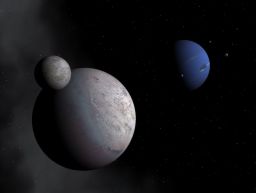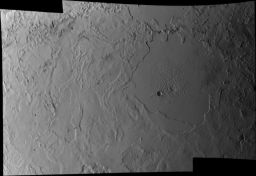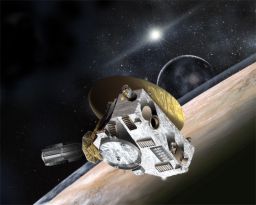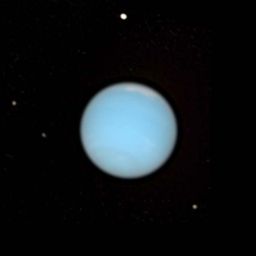Emily Lakdawalla • Nov 07, 2008
A launch to Neptune in 2019?
The Outer Planets Assessment Group, or OPAG, is meeting this week at Arizona State University, primarily to examine the progress of the two major Outer Planets flagship mission studies, one of which will be selected by NASA and ESA in January. The two missions that are being considered are a Europa Jupiter System Mission or EJSM and a Titan Saturn System Mission or TSSM. Not long after the meeting is over, the presentations on these proposals should be posted to the OPAG website, so if you're curious about them, go check those presentations out.
I generally don't pay a lot of attention to missions that are still on the drawing board, because I have quite enough to keep me busy just following missions that are active or are just about to launch. So I've been actively avoiding learning about EJSM or TSSM -- I'll pay more attention when one of them gets selected. Still, my curiosity was piqued by a presentation that was on the OPAG schedule for yesterday afternoon: the proposal of a New Frontiers mission to Neptune. So I tuned in to listen to that.
The next flagship mission to an outer planet will either be going to Jupiter or Saturn. That'll be active in the mid 2020s. There is some desire for the next flagship mission after that to go to the Neptune system. But, for a variety of reasons, it's not going to happen anytime soon -- not until the 2040s at least -- and there's no telling whether a compelling case will be made for the next flagship to go to the planet, Jupiter or Saturn, that didn't get a mission in the 2020s. So it could be a long, long, long time before we visit Neptune (nevermind Uranus).

Craig Agnor, from image maps provided by Steve Albers, Jerry Gardner, James Hastings-Trew, Constantine Thomas, and NOAA's "Science on a Sphere" project
How Neptune captured Triton?
In this artist's conception, Triton and a possible binary companion approach Neptune. Such an encounter could have facilitated Triton's capture to its inclined, retrograde orbit around Neptune. Neptune may once have had other large moons, as in this picture, but they would have been destroyed through the mayhem caused by large Triton's capture to an originally ecentric orbit.What to do? Candy Hansen and Heidi Hammel are proposing a mission called Argo that could update our understanding of the Neptune mission at the much lower cost of a New Frontiers mission. But at that price, it would not be an orbiter; it would be a flyby mission. Would it really be worth sending just a flyby mission to Neptune?
If a Neptune flyby was all that we would get out of a New Frontiers mission, the answer would probably be no. But Argo proposes to study Neptune and Triton in a flyby, then go on to a couple of Kuiper belt objects, just as New Horizons is going first to Pluto, then to a couple of Kuiper belt objects. In fact, to keep costs in line, Argo's design would borrow a lot from New Horizons.

NASA / JPL / Ted Stryk
High-resolution view of Triton's surface from Voyager 2
On its closest approach to Triton on August 25, 1989, Voyager snapped several high-resolution mosaics. Triton is considered to be a Kuiper belt object that was captured into Neptune orbit, an event that would have heated it and altered its surface through cryovolcanism. As a result, there are few large craters; a few small ones are visible in this mosaic.Argo, on the other hand, would be flying by Neptune, which is the third-most-massive planet in the solar system. Flying by Neptune opens up a huge cone of opportunity; with a gravity assist from Neptune, Argo could choose a course into the Kuiper belt that lies anywhere within 60 degrees of its Neptune trajectory -- a total breadth of 120 degrees -- and that's without using any propulsive assistance at all. The Argo mission could choose to visit any one of nine large (400 kilometers in diameter or larger) Kuiper belt objects, some of which are binary (two for the price of one -- like Pluto and Charon), or any one of 40 objects between 200 and 400 kilometers in diameter. I assume that, if the mission were to be selected, they'd eventually settle on a course that could take it past two or more objects of diverse types, trading among all the variables of interest to the science team -- size, surface properties, number of companions, and so on.
It's a neat idea. It can't happen in the next New Frontiers opportunity because the U.S. doesn't have enough plutonium available for the next New Frontiers to be nuclear-powered. So it has to be New Frontiers 4, which implies a launch date in 2019 or 2020, with the Neptune flyby happening around 2027. Just to be clear, Argo hasn't been selected for New Frontiers 4; the announcement of opportunity for New Frontiers 4 won't happen until 2013, and then Argo will have to compete against all the other no doubt compelling proposals. It's not a done deal, just a neat idea.
There was a funny moment in the presentation, when Hansen put up a grid identifying the positions on the science team that will eventually need to be filled. With the spacecraft not launching for a decade, and not reaching its first real science target for two decades, now might not be the best time to identify the science team. "It's not going to be any of us," joked someone from the audience. It's true; there will certainly be some people on that team who are now established researchers, but the majority would likely be people who are currently in graduate school or college. Maybe even high school. Are you in high school right now? Want to drive a spacecraft to Neptune? Argo might just be your chance.
Support our core enterprises
Your support powers our mission to explore worlds, find life, and defend Earth. You make all the difference when you make a gift. Give today!
Donate

 Explore Worlds
Explore Worlds Find Life
Find Life Defend Earth
Defend Earth



